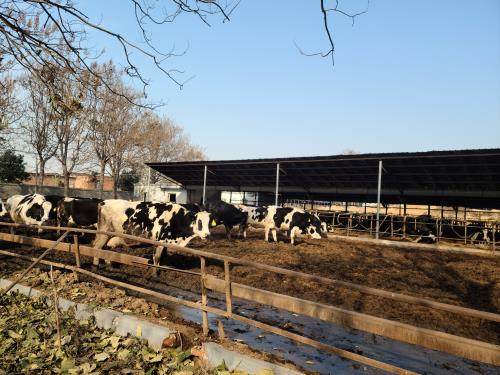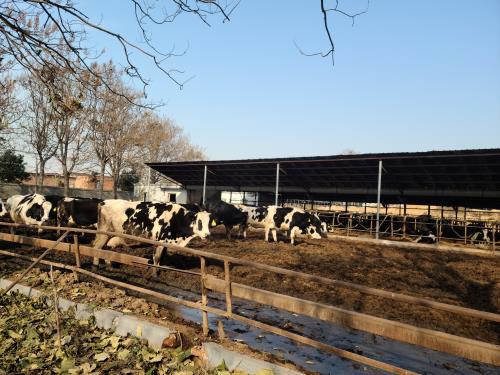Friends who breed cows will find that retained afterbirth is a common disease in cows after giving birth, and it is easy to develop other postpartum diseases. In particular, the incidence of endometritis caused by retained afterbirth observed through cattle B-ultrasound machine is significantly increased. , causing the cows to be infertile, delaying estrus, increasing the number of breedings, affecting the breeding sales of the cows, and even directly culling the cows if they cannot be bred. Therefore, when a cow encounters a retained fetal membrane, it should be dealt with promptly. to avoid subsequent economic losses.
What is retained afterbirth in cows: After a cow gives birth, the afterbirth is usually discharged on its own within 4 to 8 hours, and generally does not exceed 12 hours. If it is discharged within 12-24 hours, it is considered to be delayed. If it is not completely discharged after 24 hours, that is It is retained fetal membrane or retained fetal membrane. Retained afterbirth is further divided into: retained afterbirth entirely and partially retained afterbirth. Cattle B-ultrasound machine is used to analyze the reasons why cows retain their afterbirth. There are many reasons why cows retain their afterbirth, which mainly include the structure of the cow's own placenta, nutritional status, individual differences, various stresses, etc. Common causes include lack of calcium, selenium, vitamin A, vitamin E and other minerals in the feed during the feeding process, lack of exercise during pregnancy, twins or dystocia, etc., which causes postpartum uterine contractions. Secondly, through the analysis of B-ultrasound images of cows, cows suffering from chronic metritis, brucellosis, infection of fetal membranes and endometrium can also cause retained fetal membranes.
Imported cattle B-ultrasound machine
Treatment methods for cows with retained afterbirth: First, cut it directly from the vagina; second, drop something outside the afterbirth. In fact, both of the above methods are undesirable. In modern terms, it is unscientific. For example, if it is cut off directly, the remaining afterbirth will retract into the uterus, so that it will not be easily expelled from the body when it falls off in the future. Dropping things may also strangle the vagina, and may even cause uterine prolapse. So when encountering such a thing, I still recommend drug treatment and direct manual peeling.
Medication to treat postpartum retention in cows: When it comes to medication, many friends who raise cattle have some folk remedies for treating postpartum retention in cows. For example, there are many Chinese herbal medicine prescriptions on the Internet. Western medicine is mainly convenient and efficient. For example, Gong Yanjing, Xi Keling, etc. The following is a medicine that a cow friend bought in a veterinary store to treat retained fetal membranes in cows. If it doesn't come down after medical treatment, manual peeling is the only option. The principle of manual peeling is that if it is easy to peel, peel it; if it is not easy to peel, do not peel it by force; if the peeling is not clean, it is better not to peel it; when the body temperature of the affected cow is high, it cannot be peeled. Peeling off the afterbirth should be done "quickly (peel off within 5 to 20 minutes), cleanly (aseptic operation, peel off completely), and lightly (movements should be gentle, not rough)", and it is strictly forbidden to damage the endometrium. Sick cows suffering from acute endometritis and elevated body temperature should not be stripped. I won’t go into the specific steps. Anyway, I suggest you don’t do it yourself. It’s best to call a veterinarian. Because I'm afraid of brucellosis. No matter how it is handled, anti-inflammatory drugs should be injected promptly. After the fetal membrane is removed, 500 to 1000 ml of normal saline can be perfused into the uterus, plus 4 grams of oxytetracycline. Clean the uterus. The main thing for cows with retained placenta is to prevent it and properly mix the feed. In the early and middle stages of pregnancy, the amount of concentrate can be appropriately increased. In the later period and 1 to 2 weeks before delivery, the concentrate should be reduced and green and juicy feed should be increased. Appropriately increase the amount of activity. When the cow is 1 to 2 months pregnant, the amount of activity is relatively small. When the cow is 8 to 9 months pregnant, the amount of activity is relatively large. Exercise outside the house for no less than 4 hours a day. When the cow is 45 days and 15 days away from the expected date of delivery, intramuscularly inject sodium selenite VE once, 5 ml each time; let the cow drink 2000 to 5000 ml of warm salt water after delivery; it can also be used to treat the inability to discharge the afterbirth 2 to 3 hours after delivery. Many cattle are injected with 100-150U of oxytocin, which has a significant preventive effect on retained fetal membranes in cattle.








